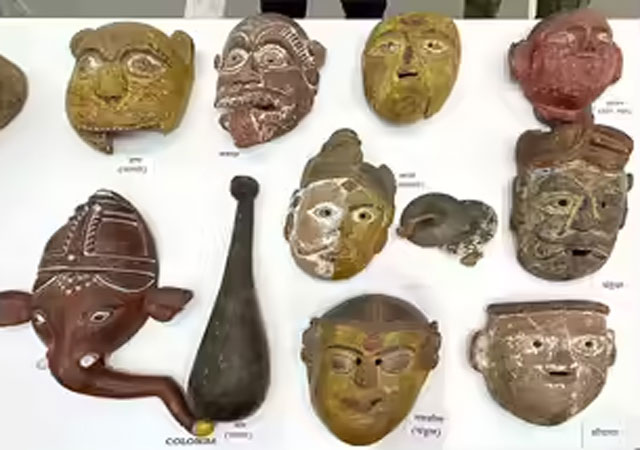Daijiworld Media Network - Quepem
Quepem, Oct 28: Goa’s centuries-old folk theatre Perni Zagor, once a vibrant part of village temple festivities, is now struggling to survive, with only a few ageing artistes and families keeping the ancient masked dance-drama alive.
Eighty-year-old Mohan Kavlu Perni from Malkarne in Quepem still remembers holding a banner as a 10-year-old during a Zagor performance. Today, he stands among the last few performers of this traditional art form that blends devotion, mythology, and storytelling through vividly painted wooden masks.

“When I was a child, winter was the busiest season with over 30 temple zatras in less than two months. Now, people’s attention span has reduced and the performances rarely last an hour,” Mohan shared, displaying the century-old masks at the Art and Culture Department on Monday.
The masks used in Perni Zagor were traditionally hand-carved by the Chari community from the lightweight shivonn wood, chosen for its ease of carving. However, the craft has vanished, leaving the surviving masks — many over a hundred years old — in fragile condition.
“The mask makers stopped long ago, but we’ve preserved these masks as they are, without any touch-ups,” said Prakash Perni Vaghurmekar from Vaghurme, Ponda. His troupe last performed 60 years ago, but the masks remain a family treasure.
Mohan’s troupe of around 15 members is among the few still performing outside their village — in Sanguem, Canacona, and Salcete. Other Perni families in Poinguinim (Canacona), Colomba (Sanguem), and Morjim (Pernem) also continue the practice, though mostly within their local communities.
The performances are entirely oral traditions, featuring verses largely in Konkani, accompanied only by zhanz (cymbals) and dholki (two-headed hand drum). Each family worships its set of masks annually as part of religious rituals.
“When we worship Lord Ganesh during Ganesh Chaturthi, we also worship our mask of Ganesh — it’s part of our devotion,” said Sudhakar Perni (53) from Malkarne.
Younger artistes like Vishal Perni from Colomba are now stepping forward to keep the tradition alive. “The masks in our family are nearly 170 years old. They were likely painted with organic colours, and we don’t want to tamper with them,” he said.
According to anthropological researcher Pandurang Phaldesai, in his study ‘Perni Zagor’, the art form is among Goa’s most endangered. “Perni Zagor follows global mask dance traditions but is deeply rooted in the Western Ghats’ cultural and historical landscape. It carries prehistoric shamanistic and Neolithic elements in its themes, symbols, and gestures,” Phaldesai noted.
As the wooden masks deteriorate and the number of trained performers dwindles, Perni Zagor faces an uncertain future. What was once a thriving art form celebrating faith and folklore now stands as one of Goa’s most fragile cultural legacies — waiting for revival before it fades into history.